1. 算法思路:
类似于选择排序,每次找到极角最小的点加入到点集 result 中,具体步骤见 2.2
时间复杂度 :O(n⋅h)
其中 h 是凸包中顶点的数量,因此最坏的情况是 O(n2)。
2. 示例代码:
2.1 import
1
2
3
| import java.util.*;
import primitives.Point;
import primitives.Polygon;
|
2.2 march算法
1
2
3
4
5
6
7
8
9
10
11
12
13
14
15
16
17
18
19
20
21
22
23
24
25
26
27
28
29
30
31
32
33
34
35
36
37
38
39
40
41
42
43
44
45
46
47
48
49
50
| public static Polygon Jarvis(ArrayList<Point> pointsList) {
ArrayList<Point> points = (ArrayList<Point>)pointsList.clone();
ArrayList<Point> result = new ArrayList<Point>();
Point p0 = getLowestPoint(points);
result.add(p0);
points.remove(p0);
Point pE = points.get(0);
Point candidate;
for(int i = 1; i < points.size(); i++) {
candidate = points.get(i);
if(crossProduct(p0, candidate, pE) < 0) {
pE = candidate;
}
}
Point next = null;
Point last = p0;
do {
next = points.get(0);
for(int i = 1; i < points.size(); i++) {
candidate = points.get(i);
if (crossProduct(last, candidate, next) > 0 ||
crossProduct(last, candidate, next) == 0 &&
last.dist(candidate) > last.dist(next)) {
next = candidate;
}
}
result.add(next);
points.remove(next);
last = next;
} while(next != pE);
return new Polygon(result);
}
|
1. 先找最低点 P0;
2. 对 points 进行遍历,找到极角最大点,即为 凸包的最后一个顶点 PE,该处为 P9;
3. 再在 points 中找到以点 last 为轴,极角最小的点 next ,若极角相同,则取离 last 最远的;
4. 找到后,将极角最小的点 next 加入点集 result ,同时将 last 赋为 next ;(last 是变化的)
5. 重复进行步骤 3. ~ 4. 的操作,直至找到最后一个顶点 PE ,即 P9 。

| points |
result |
last |
next |
| P0,P1,P2,P3,P4,P5,P6,P7,P8,P9 |
|
NULL |
NULL |
| P1,P2,P3,P4,P5,P6,P7,P8,P9 |
P0 |
P0 |
NULL |
| P2,P3,P4,P5,P6,P7,P8,P9 |
P0,P1 |
P0 |
P1 |
| P3,P4,P5,P6,P7,P8,P9 |
P0,P1,P2 |
P1 |
P2 |
| P3,P4,P6,P7,P8,P9 |
P0,P1,P2,P5 |
P2 |
P5 |
| P3,P4,P7,P8,P9 |
P0,P1,P2,P5,P6 |
P5 |
P6 |
| P3,P4,P7,P9 |
P0,P1,P2,P5,P6,P8 |
P6 |
P8 |
| P3,P4,P7 |
P0,P1,P2,P5,P6,P8,P9 |
P8 |
P9(跳出循环) |
2.3 其他方法
2.3.1 叉积
1
2
3
4
5
6
7
8
9
10
|
private static double crossProduct(Point p0, Point p1, Point p2) {
return (p1.getX() - p0.getX()) * (p2.getY() - p0.getY()) -
(p2.getX() - p0.getX()) * (p1.getY() - p0.getY());
}
private static boolean isLeftTurn(Point p0, Point p1, Point p2) {
return (crossProduct(p0, p1, p2) > 0);
}
|
P0P1×P0P2

2.3.2 获得最低点
lowest-then-leftmost point(LTL)
1
2
3
4
5
6
7
8
9
10
11
12
13
14
15
16
17
| private static Point getLowestPoint(ArrayList<Point> points) {
Point result = points.get(0);
Point candidate;
for (int i = 1; i < points.size(); i++) {
candidate = points.get(i);
if (candidate.getY() < result.getY() ||
candidate.getY() == result.getY() && candidate.getX() < result.getX()) {
result = candidate;
}
}
return result;
}
|

